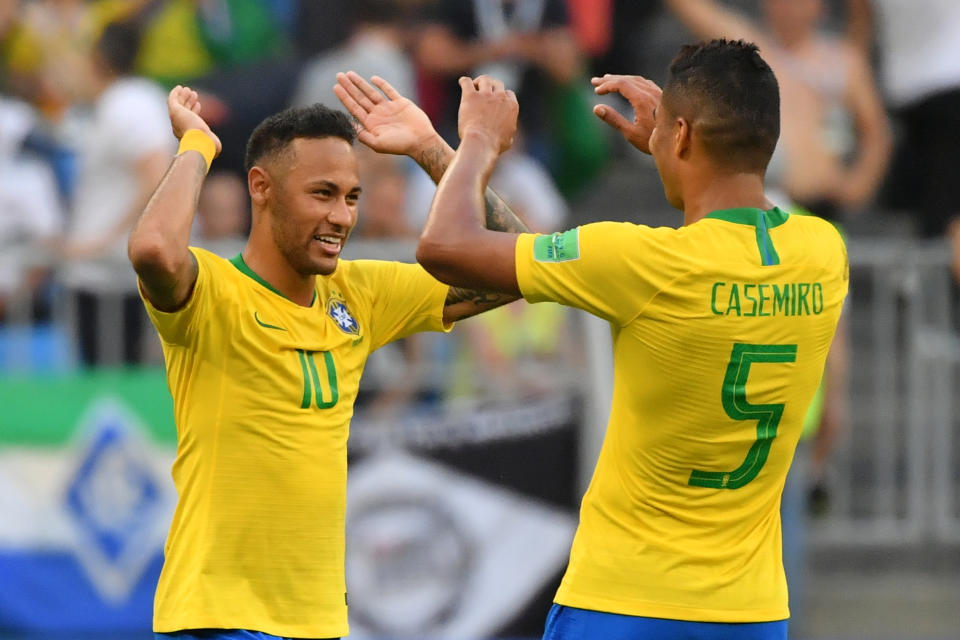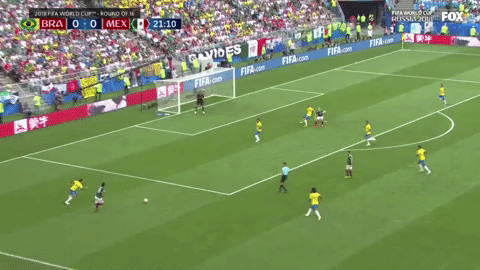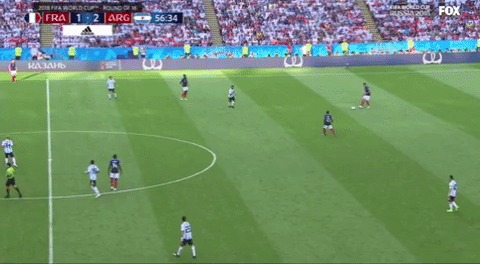8 players, matchups and tactics that will decide the World Cup quarterfinals
The 2018 World Cup quarterfinals kick off on Friday. The matchups – France vs. Uruguay, Brazil vs. Belgium, England vs. Sweden, Croatia vs. Russia – range from mouthwatering to intriguing to meh.
The following is a look at all eight teams, and the eight things – players, injuries, suspensions, tactics, tendencies and more – that could send those teams through to the semifinals … or home.
1. Brazil’s defensive midfield uncertainty
Brazil vs. Belgium, Friday, 2 p.m. ET, Fox Sports 1, Telemundo

The single biggest threat to the World Cup favorites is the yellow card suspension of their defensive midfield rock, Casemiro. He’s Brazil’s second-most important player. He’s a one-man defensive shield:

He covers for fullbacks who bomb forward. He goes sideline to sideline, blanketing the width of the field, making Brazil as impervious to counterattacks as can be:

And against the World Cup’s most high-powered attack, he’ll be absent. How will the Selecao cope?
Fernandinho is the probable like-for-like replacement. He’s actually more polished on the ball, and is coming off the best season of his career at Manchester City. But will he be able to track and thwart Eden Hazard and Kevin De Bruyne like Casemiro would?
2. Belgium’s (lack of?) midfield structure
Brazil vs. Belgium, Friday, 2 p.m. ET, Fox Sports 1, Telemundo
Belgium manager Roberto Martinez has a fascinating decision on his hands. He’s spent the past four months stuffing all four of his prolific attackers – Romelu Lukaku, Eden Hazard, Dries Mertens and Kevin De Bruyne – into his starting 11. And results were overwhelmingly positive … until this week.
Japan exposed the absurdity of the setup. Brazil surely can too if Martinez sticks with it. So will he sacrifice one of the four to make way for a second defensive midfielder? Might he completely rejigger his 11? Or will he try to outgun Casemiro-less Brazil, and risk being run ragged?
We broke down the dilemma in detail here.
3. Uruguay’s fractured strike partnership
France vs. Uruguay, Friday, 10 a.m. ET, Fox Sports 1, Telemundo
Just as Uruguay appeared to be hitting full stride, the most untimely of injuries popped up to dampen dreams of a deep run. Edinson Cavani strained his calf after beating Portugal with two gorgeous goals. He’s likely out – though possibly available off the bench – for Friday’s showdown with France. And, well, that’s a big freakin’ deal.
Cavani and Luis Suarez are far from a two-man team. But they allow Uruguay to be what it is, because they’re capable of being a two-man attack. They accentuate each other’s strengths. Their dual threat inevitably leaves at least one isolated against a defender. And they’re so well-rounded. They can win those individual battles, then get their heads up and bring the other into play. They move as well as anybody in the final third. Oh, and they can finish, too.
That, right there, is Cavani’s Portugal brace in a nutshell. Even when the front two seem detached, they’re a threat to link up. Cavani created the opener by checking to the ball and picking it up near midfield on the right, while Suarez was hanging out on the back shoulder of the far fullback. Yet they still managed to effectively play an elongated give-and-go!
Suarez finds Cavani at the back post to put Uruguay up 1-0 early in the game! pic.twitter.com/BUlHpqWSI0
— FOX Soccer (@FOXSoccer) June 30, 2018
Suarez didn’t even touch the ball in the buildup to the second. But a trademark hip-check of Pepe turned nothing – a goal kick – into something.
PURE. CLASS.
Cavani one-times a curler into the back of the net to re-take the lead for Uruguay. pic.twitter.com/JZhmTqE1s4
— FOX Soccer (@FOXSoccer) June 30, 2018
With Cavani out, that nothing-into-something danger is drastically diminished. Manager Oscar Tabarez, therefore, has a dilemma: Does he stick to his defensive structure and rely on a moment of magic from Suarez? Or does he concoct other attacking methods that are more systemic or scripted?
He could call on Cristhian Stuani or Maxi Gomez as a replacement. Or he could retreat into a 4-5-1. Either way, Uruguay won’t be the same without its Round of 16 hero. And even if he does make a miraculous recovery, he likely won’t be at full strength.
4. Can France unlock Uruguay?
France vs. Uruguay, Friday, 10 a.m. ET, Fox Sports 1, Telemundo
Anybody interested in a quarterfinal guarantee? Here’s one: France-Uruguay won’t come anywhere close to matching the seven goals of France-Argentina six days earlier.
Because Kylian Mbappe isn’t running through Uruguay’s whole team unimpeded. France isn’t catching the Uruguayans out on the counter. Especially if Cavani is out, the underdogs will turn the first of four quarterfinals into a slog. They’ll challenge France to break them down. And that’s not something Les Bleus have consistently been able to do.
They have, however, introduced one interesting wrinkle in Russia that’s helped. Didier Deschamps deployed Blaise Matuidi as a unique box-to-box left midfielder against Peru and Argentina. Especially in the Round of 16, Matuidi tended to drop in alongside N’Golo Kante, allowing Paul Pogba to venture forward into his preferred position closer to goal:

On other occasions, Matuidi turned a double pivot into a central midfield three. France used the numerical advantage to initiate attacks. With Matuidi sitting, Lucas Hernandez could get forward from left back. This was the exact pattern at the root of the French equalizer:

Now, the problem: Matuidi is suspended. And there’s no replica in the French squad. How will Deschamps adjust to crack the Uruguay blockade?
Interestingly, Thomas Lemar occupied a similar role in at least one warmup friendly, and provided a pass-before-the-pass almost identical to Matuidi’s against Argentina:
We’ll see if Deschamps remembers, and if he tabs Lemar as the key that could unlock Uruguay.
5. Russia’s low block
Russia vs. Croatia, Saturday, 2 p.m. ET, Fox, Telemundo
You have likely already heard the lazy analysis of Russia: That it is the lowest ranked team at the World Cup, and therefore either bad or the ultimate Cinderella.
Here’s the real analysis: It’s the lowest ranked team at the World Cup because, with no qualifiers to occupy them, the Russians spent their pre-World Cup international breaks losing friendlies against the likes of Argentina, Brazil and France. But in those games, they gradually honed the exact 5-3-1-1 system that beat Spain.
Manager Stanislav Cherchesov caught all of us off guard by straying from the system in the group stage. But he went back to it against his first ball-dominant opponent, and it worked wonders.
Russia’s defensive rotations were nearly flawless in the Round of 16. It sat in a low block, with four midfielders in front of five defenders. It shifted sideline to sideline so well, clogging up passing lanes wherever Spain searched. There was rarely, if ever, an avenue to the top of the penalty box.

And in Aleksandr Golovin, Russia has the perfect transitional attacking midfielder – the first “1” in the 5-3-1-1. Golovin is not only Russia’s most skilled player; he’s covered more ground per game than any other individual at the World Cup.
This is Russia’s upset formula. And it’s why victory over Croatia is a very realistic possibility.
6. Croatia’s proactivity
Russia vs. Croatia, Saturday, 2 p.m. ET, Fox, Telemundo
As good as Croatia has been through four games, it still isn’t quite comfortable with proactive responsibility. And that’s why the Russia matchup – on paper the easiest of any at this stage – is concerning.
As we’ve seen, the Croats are, strangely, better equipped for clashes with a team like Argentina than one like Denmark. They took just 20 of a possible 30 points from a qualifying group in which they were far and away the most talented team. In recent years, they’ve drawn Finland at home, struggled with Kosovo, lost to Estonia, drawn China, and drawn Azerbaijan.
And Russia, as explained above, certainly fits into the “Denmark” category. The onus will be on Croatia on Saturday. Another penalty shootout would be an undesirable outcome. Can it take initiative and pummel an inferior team like it should?
7. Sweden’s outlets and link-ups
England vs. Sweden, Saturday, 10 a.m. ET, Fox, Telemundo
You’re going to hear a lot of English pundits talk about how the Swedes are tough to break down and dangerous on set pieces. And they certainly are. But there’s a bit more nuance to their attacking threat.
Sweden, collectively, has the least technical ability of the eight remaining teams. Its players, though, are so in tune with one another. Their rhythmic link-up play makes up for any talent deficit.
The best example is the understanding between the two strikers, Ola Toivonen and Marcus Berg. They win aerial duels, then play off of each other with deceptively slick touches in tight spaces.

In transition, one will keep the opposing back line stretched while the other drops off as an outlet. Sweden’s counters often flow through that deeper option. Defenders and midfielders, accustomed to the pattern, look for his feet rather than simply hoofing the ball long. They then support him and break in unison.

This, precisely, is where the absence of Zlatan Ibrahimovic is so important. Ibra would dwell on the ball, his self-importance slowing Sweden’s pace. Berg, instead, gets rid of it quickly, and the Swedes are on their way.
They will never be mistaken for Manchester City. They will rarely build conscientiously from the back. The process will not be pretty. But once they arrive with numbers around the ball in the attacking half, they’re synchronized and menacing. They’re Burnley, except legit.
8. England’s set pieces
England vs. Sweden, Saturday, 10 a.m. ET, Fox, Telemundo
England, not Sweden, has been the set piece king of the 2018 World Cup. And the one of many sources of its success is an unlikely one: the NBA.
This past February, manager Gareth Southgate was in Minneapolis for the Super Bowl. On the eve of it, he secured tickets to a Minnesota Timberwolves game. The Wall Street Journal has the explanation:
On the ride to the arena, Southgate told colleagues that he was especially curious about how NBA teams created space around the basket. He thought there might be something he could steal. Was there any way he could apply the principles of NBA plays—the pick-and-rolls, the off-ball screens, the constant movement—to the English national soccer team?
…
Southgate had so many questions about everything from how offenses create space to how defenses protect the basket that he stayed long after the game was over.
Five months later, England is essentially running the simplest of basketball inbound plays – the first one every youth team is taught, sometimes called “stack” – on corners:
Penalty to England! pic.twitter.com/uEhUAEm8Jn
— FOX Soccer (@FOXSoccer) July 3, 2018
In the group stage, it was setting picks at the top of the key – er, box:

Six of England’s nine goals have been the direct or indirect result of a corner or free kick. As evidenced by the Colombia game, it is struggling to create from open play. But that might not matter.
– – – – – – –
Henry Bushnell covers global soccer for Yahoo Sports. Have a tip? Question? Comment? Email him at henrydbushnell@gmail.com, or follow him on Twitter @HenryBushnell, and on Facebook.



